[English] 日本語
 Yorodumi
Yorodumi- PDB-2j9d: Structure of GlnK1 with bound effectors indicates regulatory mech... -
+ Open data
Open data
- Basic information
Basic information
| Entry | Database: PDB / ID: 2j9d | ||||||
|---|---|---|---|---|---|---|---|
| Title | Structure of GlnK1 with bound effectors indicates regulatory mechanism for ammonia uptake | ||||||
 Components Components | (HYPOTHETICAL NITROGEN REGULATORY PII-LIKE PROTEIN ...) x 2 | ||||||
 Keywords Keywords | MEMBRANE TRANSPORT / EM SINGLE PARTICLE / NITROGEN METABOLISM / SIGNALLING / TRANSCRIPTION / HYPOTHETICAL PROTEIN / TRANSCRIPTION REGULATION | ||||||
| Function / homology |  Function and homology information Function and homology informationregulation of nitrogen utilization / enzyme regulator activity / ATP binding / cytosol Similarity search - Function | ||||||
| Biological species |   METHANOCOCCUS JANNASCHII (archaea) METHANOCOCCUS JANNASCHII (archaea) | ||||||
| Method |  X-RAY DIFFRACTION / X-RAY DIFFRACTION /  SYNCHROTRON / SYNCHROTRON /  MOLECULAR REPLACEMENT / Resolution: 2.1 Å MOLECULAR REPLACEMENT / Resolution: 2.1 Å | ||||||
 Authors Authors | Yildiz, O. / Kalthoff, C. / Raunser, S. / Kuehlbrandt, W. | ||||||
 Citation Citation |  Journal: Embo J. / Year: 2007 Journal: Embo J. / Year: 2007Title: Structure of Glnk1 with Bound Effectors Indicates Regulatory Mechanism for Ammonia Uptake. Authors: Yildiz, O. / Kalthoff, C. / Raunser, S. / Kuhlbrandt, W. | ||||||
| History |
| ||||||
| Remark 700 | SHEET THE SHEET STRUCTURE OF THIS MOLECULE IS BIFURCATED. IN ORDER TO REPRESENT THIS FEATURE IN ... SHEET THE SHEET STRUCTURE OF THIS MOLECULE IS BIFURCATED. IN ORDER TO REPRESENT THIS FEATURE IN THE SHEET RECORDS BELOW, TWO SHEETS ARE DEFINED. |
- Structure visualization
Structure visualization
| Structure viewer | Molecule:  Molmil Molmil Jmol/JSmol Jmol/JSmol |
|---|
- Downloads & links
Downloads & links
- Download
Download
| PDBx/mmCIF format |  2j9d.cif.gz 2j9d.cif.gz | 274.3 KB | Display |  PDBx/mmCIF format PDBx/mmCIF format |
|---|---|---|---|---|
| PDB format |  pdb2j9d.ent.gz pdb2j9d.ent.gz | 223.2 KB | Display |  PDB format PDB format |
| PDBx/mmJSON format |  2j9d.json.gz 2j9d.json.gz | Tree view |  PDBx/mmJSON format PDBx/mmJSON format | |
| Others |  Other downloads Other downloads |
-Validation report
| Summary document |  2j9d_validation.pdf.gz 2j9d_validation.pdf.gz | 724.3 KB | Display |  wwPDB validaton report wwPDB validaton report |
|---|---|---|---|---|
| Full document |  2j9d_full_validation.pdf.gz 2j9d_full_validation.pdf.gz | 750 KB | Display | |
| Data in XML |  2j9d_validation.xml.gz 2j9d_validation.xml.gz | 27.2 KB | Display | |
| Data in CIF |  2j9d_validation.cif.gz 2j9d_validation.cif.gz | 46.6 KB | Display | |
| Arichive directory |  https://data.pdbj.org/pub/pdb/validation_reports/j9/2j9d https://data.pdbj.org/pub/pdb/validation_reports/j9/2j9d ftp://data.pdbj.org/pub/pdb/validation_reports/j9/2j9d ftp://data.pdbj.org/pub/pdb/validation_reports/j9/2j9d | HTTPS FTP |
-Related structure data
| Related structure data | 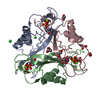 2j9cSC 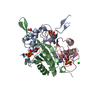 2j9eC S: Starting model for refinement C: citing same article ( |
|---|---|
| Similar structure data |
- Links
Links
- Assembly
Assembly
| Deposited unit | 
| ||||||||
|---|---|---|---|---|---|---|---|---|---|
| 1 | 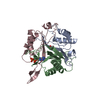
| ||||||||
| 2 | 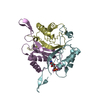
| ||||||||
| 3 | 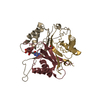
| ||||||||
| 4 | 
| ||||||||
| Unit cell |
|
- Components
Components
-HYPOTHETICAL NITROGEN REGULATORY PII-LIKE PROTEIN ... , 2 types, 12 molecules ABCDFGHIJKLE
| #1: Protein | Mass: 13311.469 Da / Num. of mol.: 11 Source method: isolated from a genetically manipulated source Source: (gene. exp.)   METHANOCOCCUS JANNASCHII (archaea) / Strain: AMJFT37 / Plasmid: PET28-D2 / Production host: METHANOCOCCUS JANNASCHII (archaea) / Strain: AMJFT37 / Plasmid: PET28-D2 / Production host:  #2: Protein | | Mass: 13327.425 Da / Num. of mol.: 1 Source method: isolated from a genetically manipulated source Source: (gene. exp.)   METHANOCOCCUS JANNASCHII (archaea) / Strain: AMJFT37 / Plasmid: PET28-D2 / Production host: METHANOCOCCUS JANNASCHII (archaea) / Strain: AMJFT37 / Plasmid: PET28-D2 / Production host:  |
|---|
-Non-polymers , 5 types, 705 molecules 

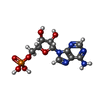






| #3: Chemical | ChemComp-ACT / #4: Chemical | ChemComp-ADP / #5: Chemical | ChemComp-AMP / | #6: Chemical | ChemComp-CL / | #7: Water | ChemComp-HOH / | |
|---|
-Experimental details
-Experiment
| Experiment | Method:  X-RAY DIFFRACTION / Number of used crystals: 1 X-RAY DIFFRACTION / Number of used crystals: 1 |
|---|
- Sample preparation
Sample preparation
| Crystal | Density Matthews: 2.17 Å3/Da / Density % sol: 43.41 % |
|---|---|
| Crystal grow | pH: 7.5 / Details: pH 7.50 |
-Data collection
| Diffraction | Mean temperature: 100 K |
|---|---|
| Diffraction source | Source:  SYNCHROTRON / Site: SYNCHROTRON / Site:  ESRF ESRF  / Beamline: ID14-1 / Wavelength: 0.934 / Beamline: ID14-1 / Wavelength: 0.934 |
| Detector | Type: ADSC CCD / Detector: CCD / Date: May 9, 2004 |
| Radiation | Protocol: SINGLE WAVELENGTH / Monochromatic (M) / Laue (L): M / Scattering type: x-ray |
| Radiation wavelength | Wavelength: 0.934 Å / Relative weight: 1 |
| Reflection | Resolution: 2.1→20 Å / Num. obs: 80980 / % possible obs: 99 % / Observed criterion σ(I): 3 / Redundancy: 4.6 % / Rmerge(I) obs: 0.16 / Net I/σ(I): 11.3 |
| Reflection shell | Resolution: 2.1→2.2 Å / Redundancy: 4.6 % / Rmerge(I) obs: 0.53 / Mean I/σ(I) obs: 3.06 / % possible all: 98.8 |
- Processing
Processing
| Software |
| ||||||||||||||||||||||||||||||||||||||||||||||||||||||||||||||||||||||||||||||||||||||||||||||||||||||||||||||||||||||||||||||||||||||||||||||||||||||||||||||||||||||||||||||||||||||
|---|---|---|---|---|---|---|---|---|---|---|---|---|---|---|---|---|---|---|---|---|---|---|---|---|---|---|---|---|---|---|---|---|---|---|---|---|---|---|---|---|---|---|---|---|---|---|---|---|---|---|---|---|---|---|---|---|---|---|---|---|---|---|---|---|---|---|---|---|---|---|---|---|---|---|---|---|---|---|---|---|---|---|---|---|---|---|---|---|---|---|---|---|---|---|---|---|---|---|---|---|---|---|---|---|---|---|---|---|---|---|---|---|---|---|---|---|---|---|---|---|---|---|---|---|---|---|---|---|---|---|---|---|---|---|---|---|---|---|---|---|---|---|---|---|---|---|---|---|---|---|---|---|---|---|---|---|---|---|---|---|---|---|---|---|---|---|---|---|---|---|---|---|---|---|---|---|---|---|---|---|---|---|---|
| Refinement | Method to determine structure:  MOLECULAR REPLACEMENT MOLECULAR REPLACEMENTStarting model: PDB ENTRY 2J9C Resolution: 2.1→19.78 Å / Cor.coef. Fo:Fc: 0.937 / Cor.coef. Fo:Fc free: 0.896 / SU B: 5.657 / SU ML: 0.154 / Cross valid method: THROUGHOUT / ESU R: 0.251 / ESU R Free: 0.213 / Stereochemistry target values: MAXIMUM LIKELIHOOD / Details: HYDROGENS HAVE BEEN ADDED IN THE RIDING POSITIONS.
| ||||||||||||||||||||||||||||||||||||||||||||||||||||||||||||||||||||||||||||||||||||||||||||||||||||||||||||||||||||||||||||||||||||||||||||||||||||||||||||||||||||||||||||||||||||||
| Solvent computation | Ion probe radii: 0.8 Å / Shrinkage radii: 0.8 Å / VDW probe radii: 1.4 Å / Solvent model: BABINET MODEL WITH MASK | ||||||||||||||||||||||||||||||||||||||||||||||||||||||||||||||||||||||||||||||||||||||||||||||||||||||||||||||||||||||||||||||||||||||||||||||||||||||||||||||||||||||||||||||||||||||
| Displacement parameters | Biso mean: 30.31 Å2
| ||||||||||||||||||||||||||||||||||||||||||||||||||||||||||||||||||||||||||||||||||||||||||||||||||||||||||||||||||||||||||||||||||||||||||||||||||||||||||||||||||||||||||||||||||||||
| Refinement step | Cycle: LAST / Resolution: 2.1→19.78 Å
| ||||||||||||||||||||||||||||||||||||||||||||||||||||||||||||||||||||||||||||||||||||||||||||||||||||||||||||||||||||||||||||||||||||||||||||||||||||||||||||||||||||||||||||||||||||||
| Refine LS restraints |
|
 Movie
Movie Controller
Controller


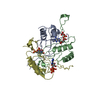

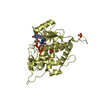

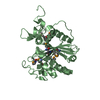
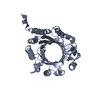
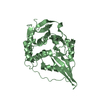

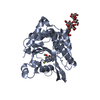
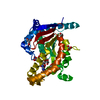
 PDBj
PDBj







